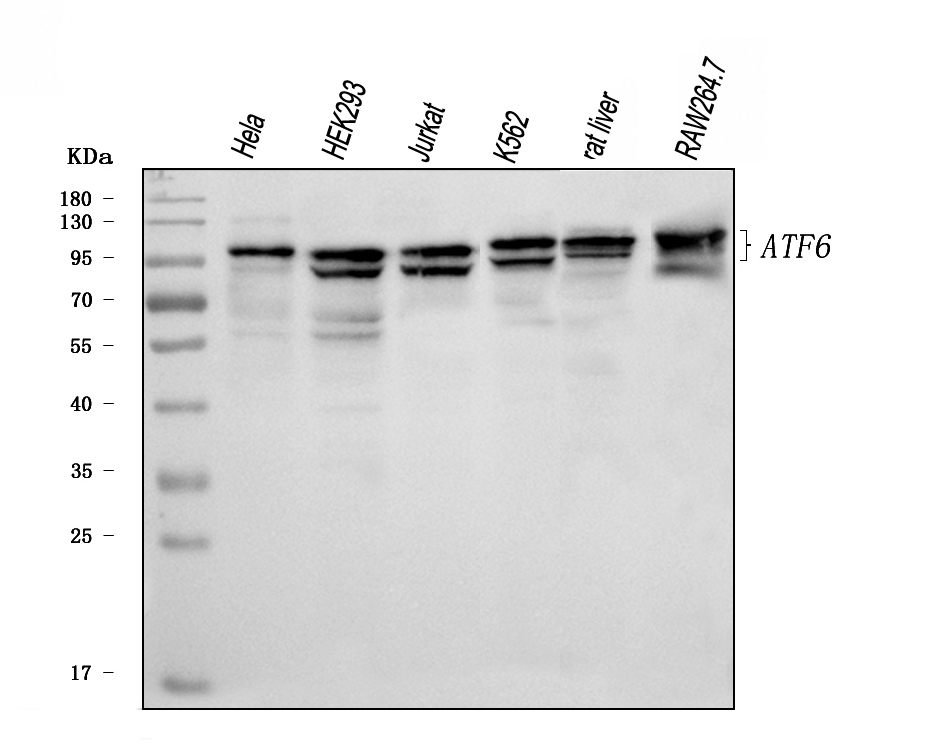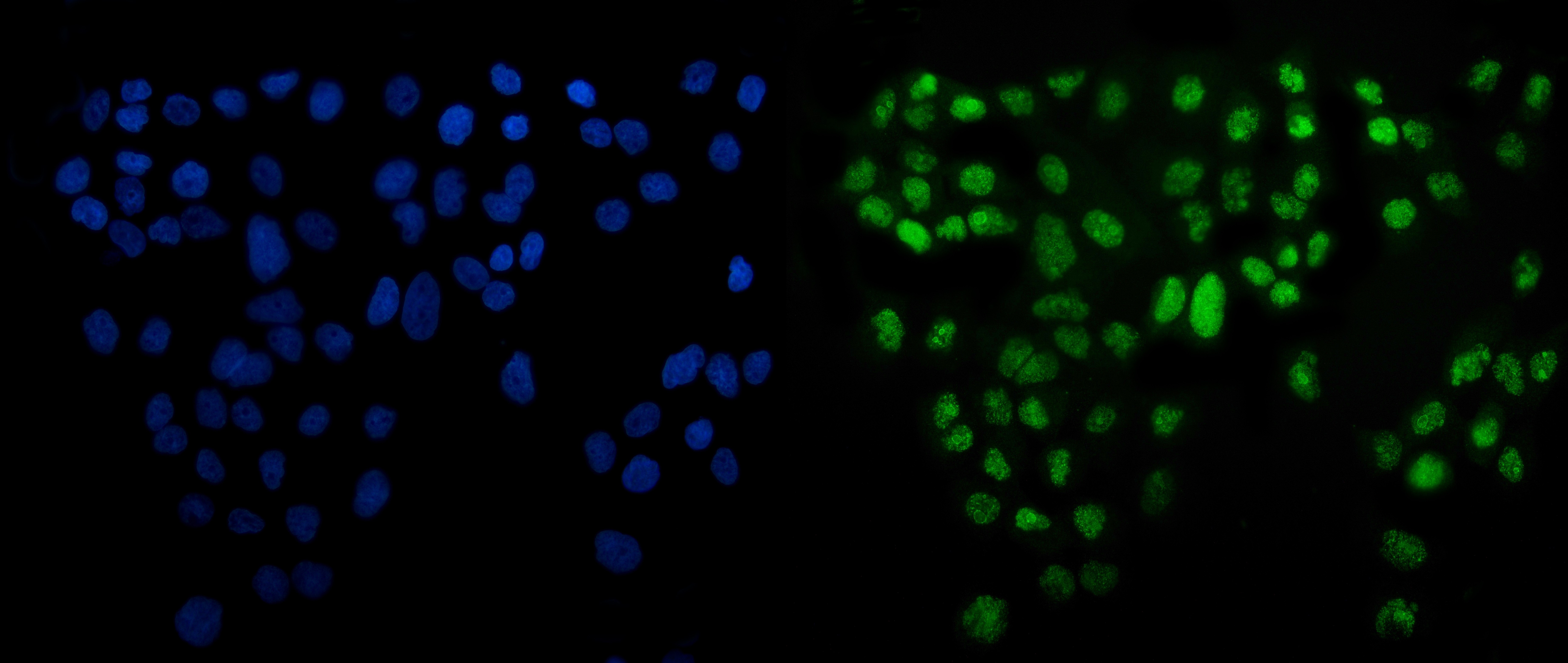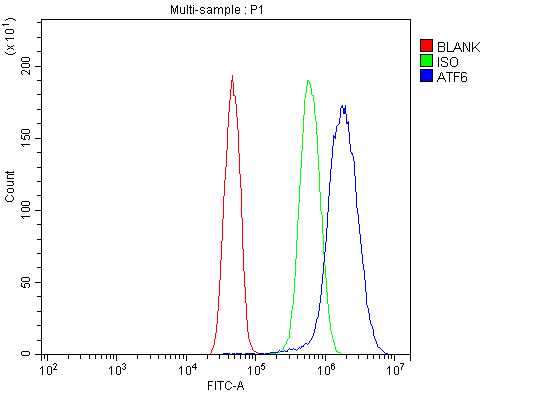| Western blot (WB): | 1:500-2000 |
| Immunocytochemistry/Immunofluorescence (ICC/IF): | 1:50-400 |
| Flow Cytometry (Fixed): | 1:50-200 |
| Enzyme linked immunosorbent assay (ELISA): | 1:100-1000 |

Western blot analysis of anti- ATF6 antibody (A00655-3). The sample well of each lane was loaded with 30ug of sample under reducing conditions.
Lane 1: human Hela whole cell lysates,
Lane 2: human HEK293 whole cell lysates,
Lane 3: human Jurkat whole cell lysates,
Lane 4: human K562 whole cell lysates,
Lane 5: rat liver tissue lysates,
Lane 6: mouse RAW264.7 whole cell lysates.
Use rabbit anti- ATF6 1:1000, probed with a goat anti-rabbit IgG-HRP secondary antibody. The signal is developed using an Enhanced Chemiluminescent detection (ECL) kit (Catalog#EK1002). A specific band was detected for ATF6 at approximately 90-100KD. The expected band size for ATF6 is at 75KD.

IF analysis of ATF6 using anti-ATF6 antibody (A00655-3).
ATF6 was detected in an immunocytochemical section of A431 cells. The section was incubated with rabbit anti-ATF6 Antibody (A00655-3) at a dilution of 1:100. DyLight®488 Conjugated Goat Anti-Rabbit IgG (Green) (Catalog # BA1127) was used as secondary antibody. The section was counterstained with DAPI (Catalog # AR1176) (Blue).

Flow Cytometry analysis of U251 cells using anti-ATF6 antibody (A00655-3).
Overlay histogram showing U251 cells stained with A00655-3 (Blue line). To facilitate intracellular staining, cells were fixed with 4% paraformaldehyde and permeabilized with permeabilization buffer. The cells were blocked with 10% normal goat serum. And then incubated with rabbit anti-ATF6 Antibody (A00655-3) at 1:100 dilution for 30 min at 20°C. DyLight®488 conjugated goat anti-rabbit IgG (BA1127) was used as secondary antibody at 1:100 dilution for 30 minutes at 20°C. Isotype control antibody (Green line) was rabbit IgG at 1:100 dilution used under the same conditions. Unlabelled sample without incubation with primary antibody and secondary antibody (Red line) was used as a blank control.

Western blot analysis of anti- ATF6 antibody (A00655-3). The sample well of each lane was loaded with 30ug of sample under reducing conditions.
Lane 1: human Hela whole cell lysates,
Lane 2: human HEK293 whole cell lysates,
Lane 3: human Jurkat whole cell lysates,
Lane 4: human K562 whole cell lysates,
Lane 5: rat liver tissue lysates,
Lane 6: mouse RAW264.7 whole cell lysates.
Use rabbit anti- ATF6 1:1000, probed with a goat anti-rabbit IgG-HRP secondary antibody. The signal is developed using an Enhanced Chemiluminescent detection (ECL) kit (Catalog#EK1002). A specific band was detected for ATF6 at approximately 90-100KD. The expected band size for ATF6 is at 75KD.

IF analysis of ATF6 using anti-ATF6 antibody (A00655-3).
ATF6 was detected in an immunocytochemical section of A431 cells. The section was incubated with rabbit anti-ATF6 Antibody (A00655-3) at a dilution of 1:100. DyLight®488 Conjugated Goat Anti-Rabbit IgG (Green) (Catalog # BA1127) was used as secondary antibody. The section was counterstained with DAPI (Catalog # AR1176) (Blue).

Flow Cytometry analysis of U251 cells using anti-ATF6 antibody (A00655-3).
Overlay histogram showing U251 cells stained with A00655-3 (Blue line). To facilitate intracellular staining, cells were fixed with 4% paraformaldehyde and permeabilized with permeabilization buffer. The cells were blocked with 10% normal goat serum. And then incubated with rabbit anti-ATF6 Antibody (A00655-3) at 1:100 dilution for 30 min at 20°C. DyLight®488 conjugated goat anti-rabbit IgG (BA1127) was used as secondary antibody at 1:100 dilution for 30 minutes at 20°C. Isotype control antibody (Green line) was rabbit IgG at 1:100 dilution used under the same conditions. Unlabelled sample without incubation with primary antibody and secondary antibody (Red line) was used as a blank control.




